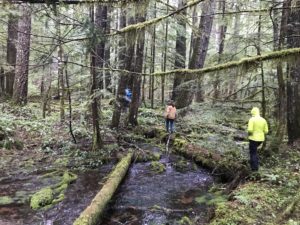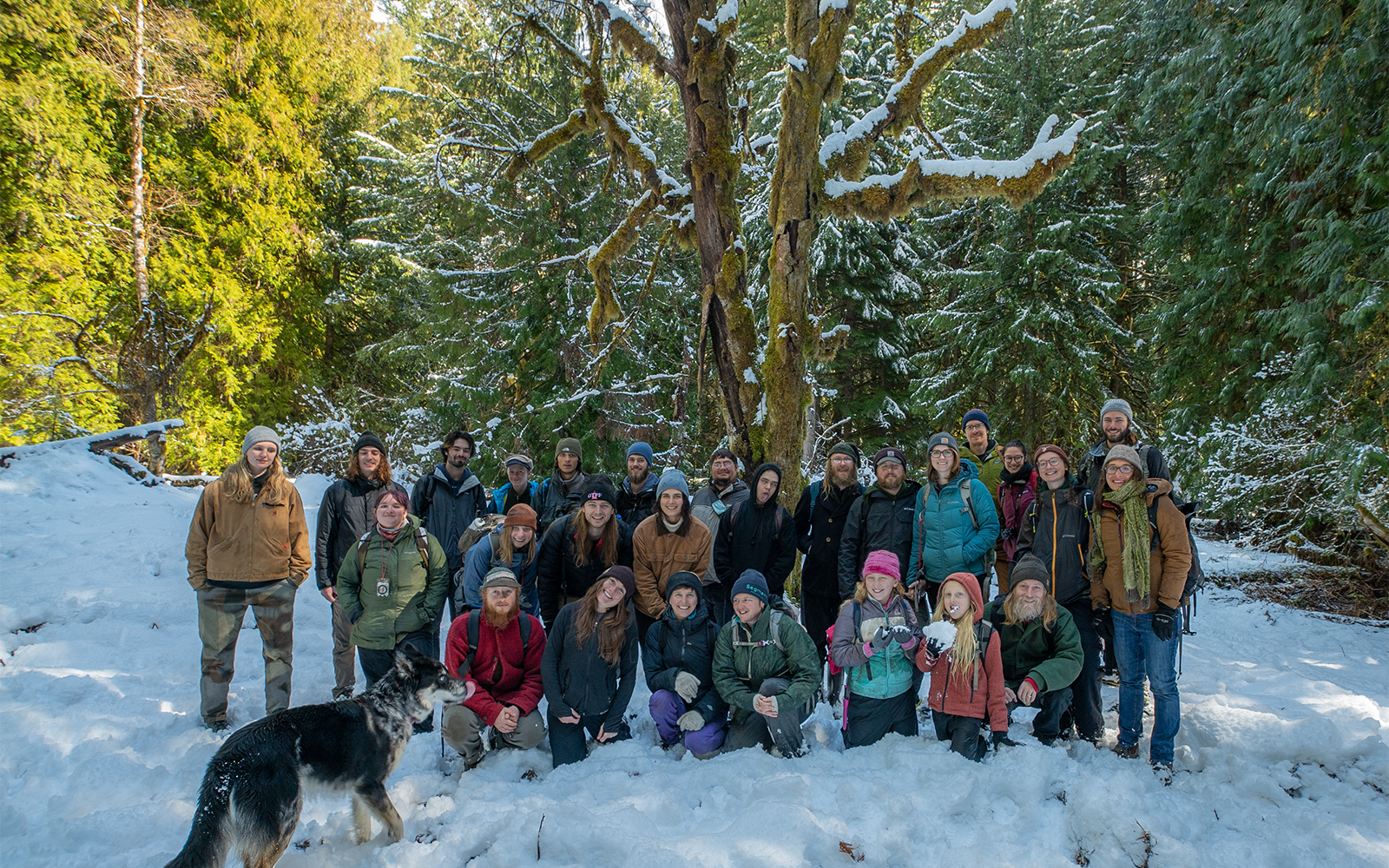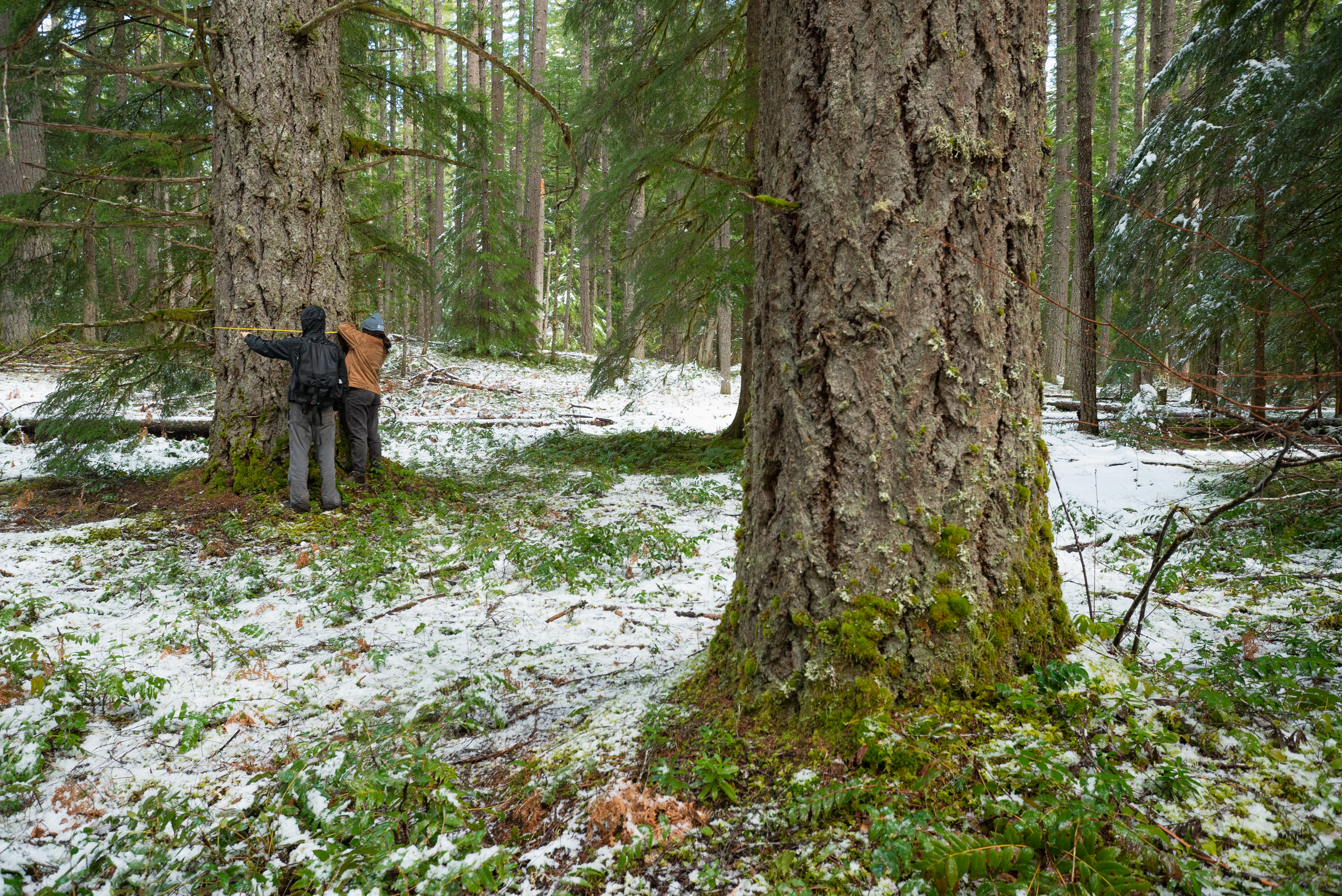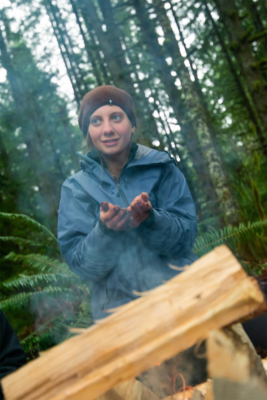
By Courtney Kaltenbach
Field Checking Intern for Cascadia Wildlands, Spring 2020
On a cool Saturday morning, over twenty people met in the Cascadia parking lot to prepare to go out on the first public field checking trip of the year into the Flat Country timber sale. Covid-19 had been declared an international pandemic three days earlier, and terms such as social distancing and flattening the curve had not yet become the center of our thoughts and interactions. We caravanned into the forest, into snowy mountains, and away from the impending crisis that would soon envelop the nation.
Flat Country is a public lands timber sale in between Eugene and Sisters at the headwaters of the McKenzie river, just north of Blue River and adjacent to the Mount Washington Wilderness. The sale encompasses over 5,000 acres of management, including 1,000 acres slated for regeneration harvest (aka clearcutting with minimal retention) in forest stands ranging between 40 and 140 years old.
The Forest Service opened up the comment period for this sale in the winter, making much of the sale inaccessible to field checking due to snow, but Cascadia Wildlands’ field-checking team has been busy exploring the units we can access, and we’re finding a lot of old, and healthy forests.
That Saturday morning, we drove up along the western border of the sale to check out unit 1300, an older stand that the Forest Service has proposed to be commercially thinned. Diving into the unit from the gravel road, we walked over soft forest ground, covered with snow, wet moss and decomposing wood. We came across a couple of rapidly flowing streams ,and we all had very different approaches to crossing. The braver of us used the leap and pray method, others strategically scouted out a route over solid logs, and some of us mistakenly picked mushy logs to step on that resulted in puddles in our boots… ok maybe that was just me. But once we crossed the last stream we walked into a beautiful meadow with an epic old alder snag (pictured above)!
 We then broke into smaller groups to tackle different parts of the unit and cover as much ground as possible. My group decided to check out the southeast corner area of the unit. We walked through the forest that was between two streams and taught folks new to field checking how to collect data such as diameter-at-breast-height measurement of trees, slope measurement and canopy coverage estimations. We animatedly shared our plant and tree identification knowledge with each other as we walked through the diverse area. One of the environmental studies students shared their dream of seeing a spotted owl before they lose the chance due to the destruction of their remaining habitat, like the lush forest full of snags and old legacy trees that we were in. I, being the new field checking intern, was mostly focused on my map — adamant to not get our group lost.
We then broke into smaller groups to tackle different parts of the unit and cover as much ground as possible. My group decided to check out the southeast corner area of the unit. We walked through the forest that was between two streams and taught folks new to field checking how to collect data such as diameter-at-breast-height measurement of trees, slope measurement and canopy coverage estimations. We animatedly shared our plant and tree identification knowledge with each other as we walked through the diverse area. One of the environmental studies students shared their dream of seeing a spotted owl before they lose the chance due to the destruction of their remaining habitat, like the lush forest full of snags and old legacy trees that we were in. I, being the new field checking intern, was mostly focused on my map — adamant to not get our group lost.
 As we entered new areas of the forest we kept exclaiming “there is no need to log this!” The trees were healthy, with scattered remnants of ancient Douglas firs, cedars and hemlocks. Natural gaps were present throughout the area and plenty of downed decomposing wood littered the forest floor. Everything was very much alive, growing and thriving.
As we entered new areas of the forest we kept exclaiming “there is no need to log this!” The trees were healthy, with scattered remnants of ancient Douglas firs, cedars and hemlocks. Natural gaps were present throughout the area and plenty of downed decomposing wood littered the forest floor. Everything was very much alive, growing and thriving.
 As we walked between the two streams, we got pretty fond of the area and named it after the fertile land between two rivers, Mesopotamia. It was an epic last jaunt in the woods with Cascadia before the state mandated lockdown! Walking through this beautiful old forest with a great group of knowledgeable folks, I fondly recalled my first field checking trip last spring at Breitenbush. After that trip I was sold on forest defense work, especially field checking, as it consists of venturing in wild places and directly utilizes experiential learning. Now, it’s a year later and I’m in a new forest, but I still feel the same sense of amazement and joy at the experience of field checking.
As we walked between the two streams, we got pretty fond of the area and named it after the fertile land between two rivers, Mesopotamia. It was an epic last jaunt in the woods with Cascadia before the state mandated lockdown! Walking through this beautiful old forest with a great group of knowledgeable folks, I fondly recalled my first field checking trip last spring at Breitenbush. After that trip I was sold on forest defense work, especially field checking, as it consists of venturing in wild places and directly utilizes experiential learning. Now, it’s a year later and I’m in a new forest, but I still feel the same sense of amazement and joy at the experience of field checking.
It is very clear that the resilient forest in this unit is well on its way to becoming an old healthy forest, and does not have the attributes that necessitate commercial thinning. Just walking through the area, I couldn’t help but feel guilty, for the forest floor was teeming with life, and I felt that I was disturbing so many complex biological processes. Logging equipment and the construction of new roads across the swiftly flowing waterways and rich forest floor, would cause drastically more harm than good in this forest stand. Cascadia Wildlands urges the Forest Service to drop all regeneration harvest (aka clearcut) for older stands in the Flat Country sale, and choose Alternative 3 in the Environmental Impact Statement.
No Clearcutting and No Logging Old Forest in Flat Country!
Field checking is the most effective way for the public to protect our forests. Field checking directly contributes to shaping our land ethic and knowledge about the incredible but threatened Pacific Northwest forests. Our government agencies too often rush through the survey process, relying more and more heavily on remote technology to determine what a forest “needs,” and often missing what’s on the ground in front of them. All to sell off the forest to the highest bidder. Oftentimes, old native forests are listed as under 80 years old, waterways go unmarked, and essential habitat for key species are overlooked. Sometimes, we uncover old-growth patches tucked deep off trail that we name—like Flat Country’s Mesopotamia—and plan to visit again and again.
Identifying and advocating for threatened forests is a responsibility of the public, and one we should take seriously. I would be more upset at the injustice of destructive logging happening in public lands except that it has given me the chance to venture into forests all over our state, build relationships with community members of all ages, and learn vast ecological knowledge. I will be spending this spring field checking with my “quarantine circle,” and I’m so grateful to be able to safely spend time outside and be of service to our forests during this pandemic. But I can’t wait for the time that we can all gather again and go field checking together!



